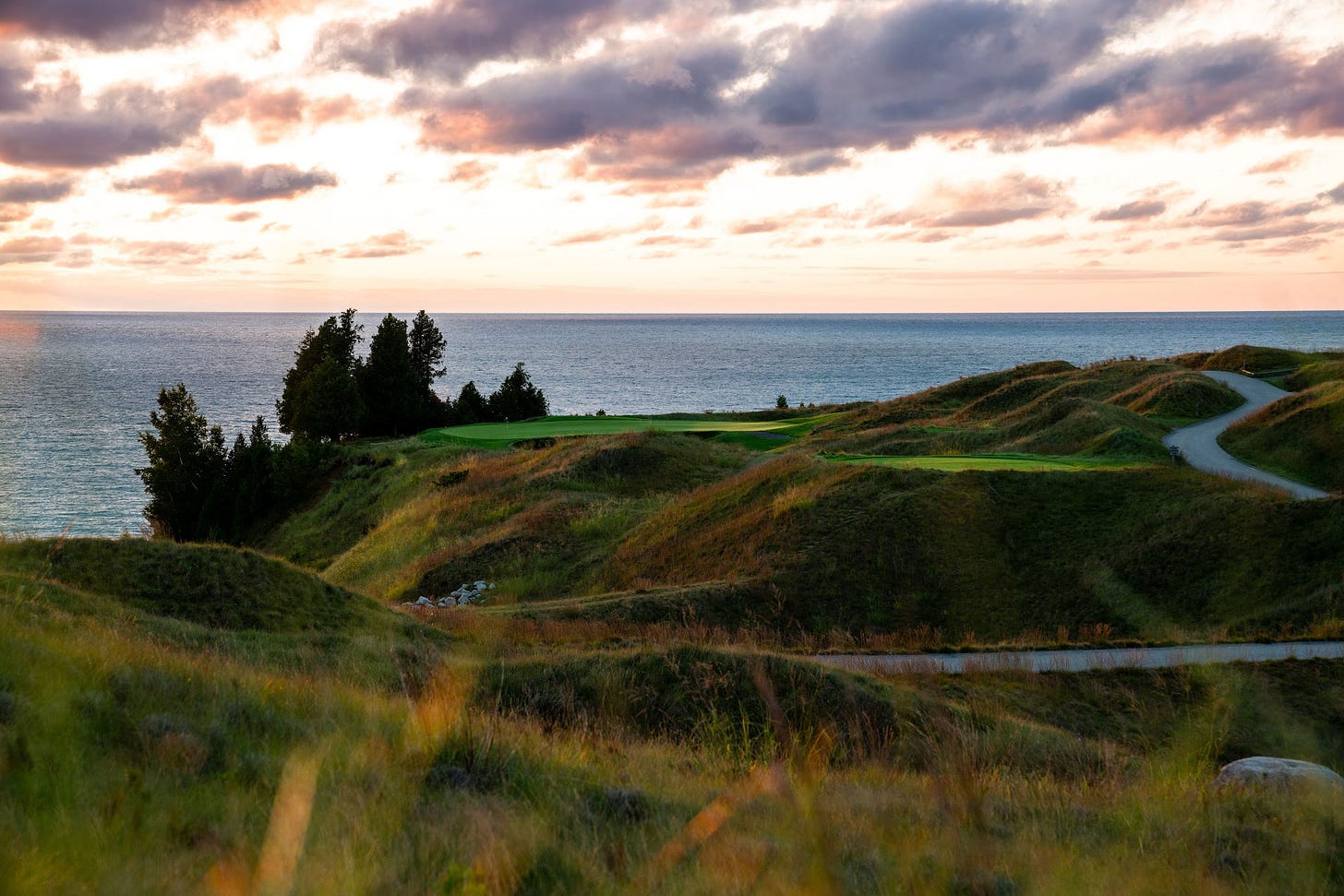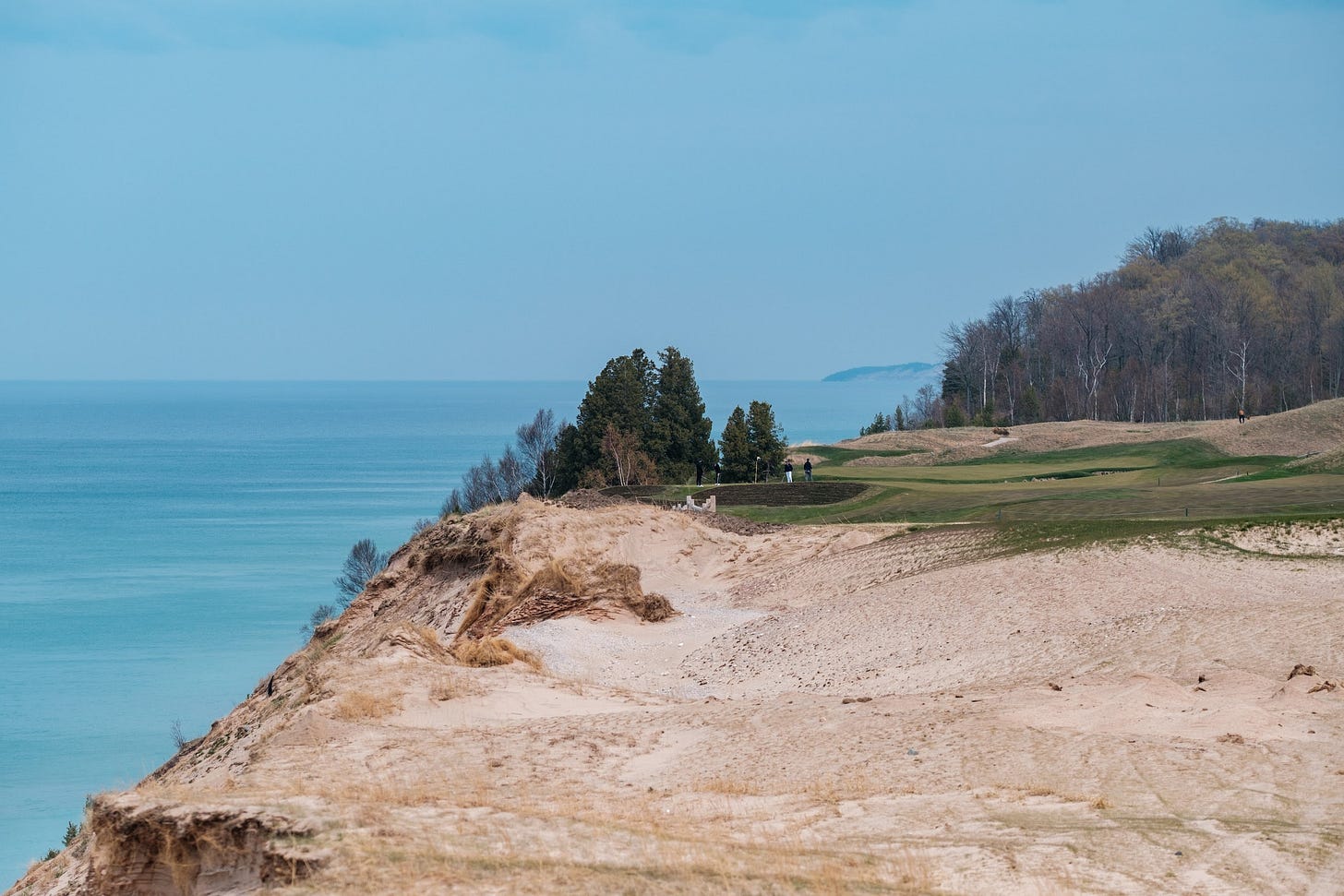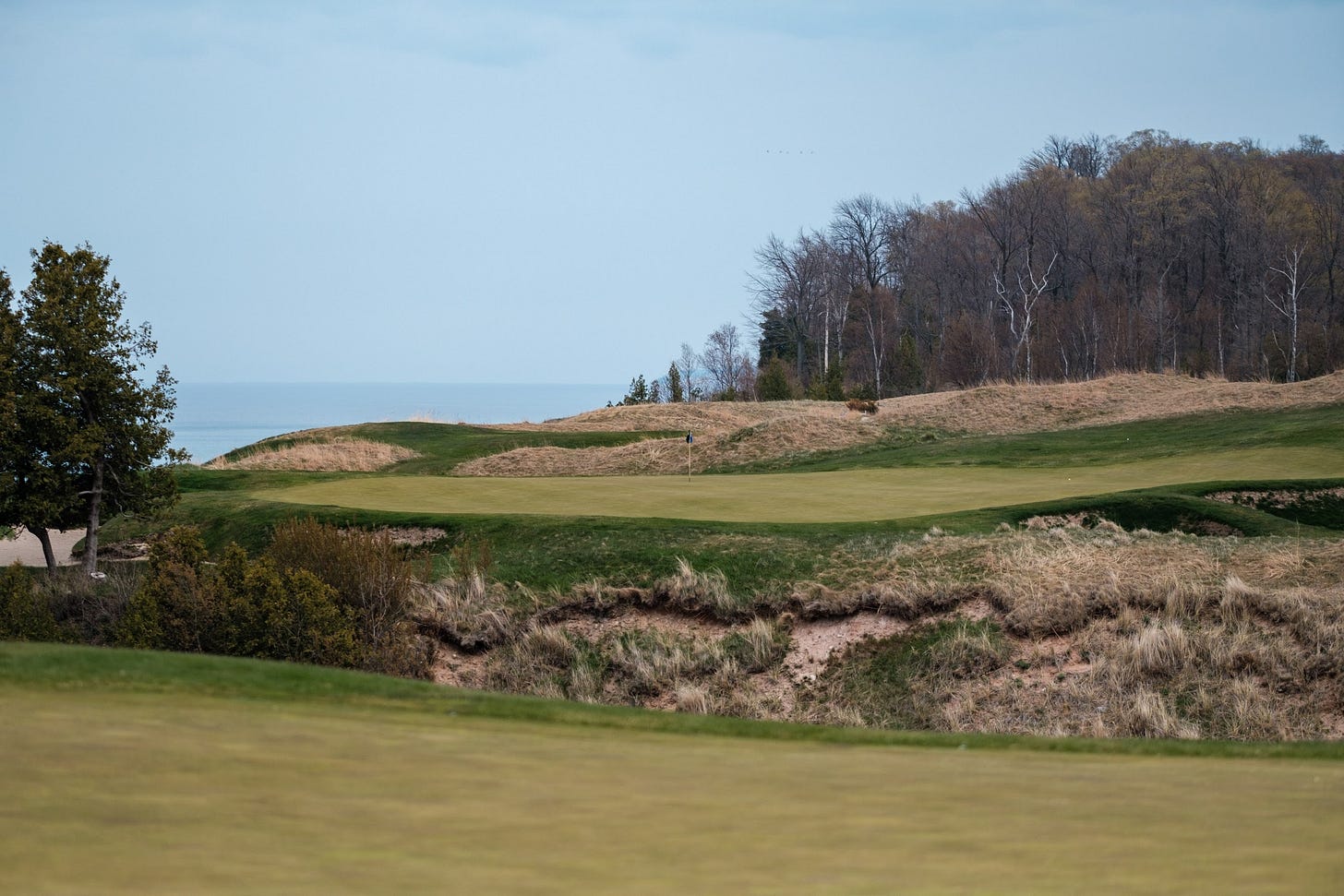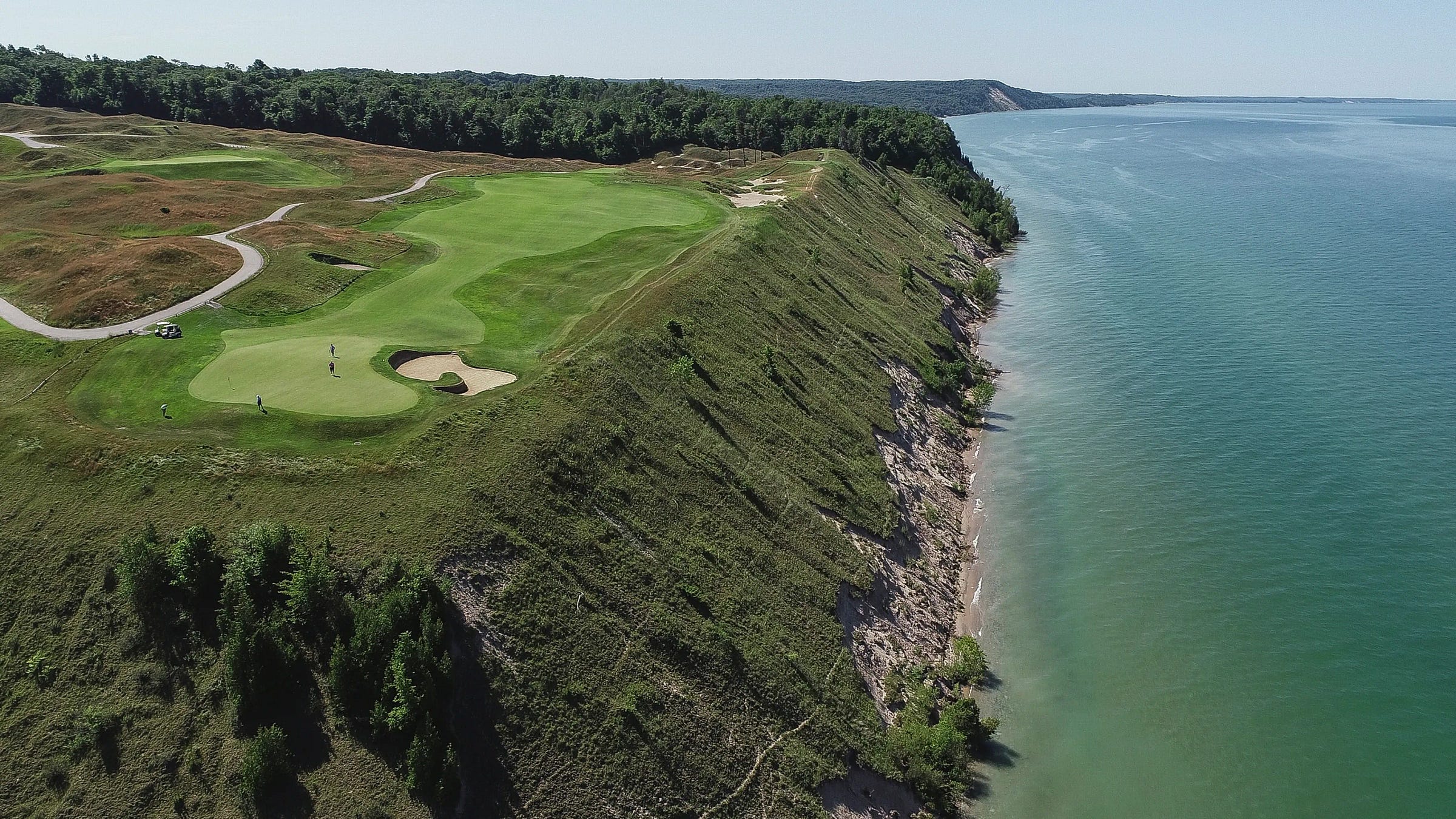If you haven’t been to Arcadia Bluffs in several years, you might notice some protective netting behind the iconic 11th green, nestled up against the bluff. If that doesn’t catch your attention, perhaps you will head to the 12th tee, grabbing a Top-Flite from your bag and preparing to fire it into Lake Michigan. Hopefully your playing partners will catch you before you start taking the club back - that’s not a thing to do at the 12th anymore. When you turn your attention back to the fairway, it should be impossible not to notice the new green off to the right, some 250 yards inland from the bluff.
The story at the 11th and 12th holes at Arcadia Bluffs today is one of erosion. Increased lake levels, caused by an increased quantity and intensity of heavy rain storms, has slowly been eating away at the shoreline, threatening the stability of the greens perched high above. Is the course ready to face a future with this constant threat from the lake below and the skies above?
One would hope so, as this isn’t a new story. It’s Arcadia’s origin story.
I find it odd that, given as much discussion as I hear about the merits of Arcadia Bluffs, and debates over whether the Bluffs course or the South course is the better of the two, the discourse almost never includes the story of the resort’s beginnings. It’s not a positive story, sure, but willful ignorance of the property’s past can’t be a healthy thing, either for the future of the resort or the future of golf in Michigan. I took a deep dive through the coverage of Arcadia’s construction, and the ensuing fallout, to make sure that I still had an accurate memory in my head of what occurred.
The original Bluffs property, approximately 245 acres, was formerly covered in orchards and dense woods, sitting on the edge of a dune bluff some 150 feet above Lake Michigan. In 1997, RVP Development, the operation of Arcadia Bluffs owner Richard Postma, clear-cut more than 80 acres of trees to create the routing for the Bluffs course.
Already a treacherous decision given the instability of the sandy soil, a heavy rain storm in September 1998 overwhelmed the water retention system, leading to a massive erosion event resulting in thousands of tons of sediment pouring down a ravine between what is now the 12th and 13th holes, and into Lake Michigan.
These are sort of the basic facts of that fateful year of development for the course. Was this an unlucky fluke, with an unforeseeable weather event occurring at exactly the wrong time to wreak havoc on the property? Or was this a negligent oversight and irresponsible stewardship of a sensitive piece of land? This would be the main conflict between environmentalists and the property developers that would play out in court over the next few years.
Early criticism from those opposed to the project, such as Keith Schneider, deputy director of the Michigan Land Use Institute, painted Postma as an “overzealous developer”, accusing him of "running roughshod" over the property to build his course. The pollution of Lake Michigan was an “environmental catastrophe”, according to Schneider, and a "prominent symbol of corporate neglect for natural resources."
Others were more guarded in their criticism, while still recognizing the negative impact it would have on the perception of the game of golf. Greg Lyman, director of environmental programs for the Golf Course Superintendents Association of America (GCSAA), called the accident a "terribly unfortunate circumstance. It gave the golf industry in Michigan a black eye." John LaFoy, then-president of the American Society of Golf Course Architects, echoed the black eye sentiment almost verbatim. ''That is the type of thing we've really tried to avoid, because it gives everyone a black eye.''
By April of the following year, Postma and RVP Development could add the state of Michigan to their list of opponents, as then-Michigan Attorney General Jennifer Granholm and Manistee County Prosecutor Dennis Swain together filed suit against RVP in 1999. They charged the group with blatant and willful disregard for the law for water pollution caused by soil erosion, which at the time was considered the worst coastal erosion event in the Lake Michigan basin. The state sought $425,000 in civil penalties, with the case lasting four years before being settled in August 2023. In the settlement, RVP agreed to pay a $125,000 fine to the DEQ (the Department of Environmental Quality, these days now known as EGLE), making it the largest-ever penalty paid to the state for water pollution caused by soil erosion at that time. The case also prompted the state to eventually strengthen its soil erosion control law.
The case didn’t come and go quietly, however, as it was marked by public personal attacks on both sides. Postma was quoted in a Grand Rapids Press article in 1999 regarding the lawsuit, "I'll let a circuit judge tell DEQ where they can shove it." He also purchased a two-page ad in a local newspaper at the time, defending the course’s design and charging Granholm with initiating a politically-motivated attack. She was making him “a poster child for her campaign of the future,” he insisted.
''Postma's perception of the political landscape in Michigan is as poor as his ability to construct a golf landscape,'' Granholm fired back, justifying the case by adding that Dennis Swain, the prosecuting attorney for Manistee County who joined the lawsuit, was a Republican. She also contended that the course was so poorly designed that it coated nearby beaches with mud from the site’s runoff, and needled, “instead of creating a golf course, he's creating a massive sand trap.”
One of the tenets of golf course design, drainage, was brought under examination in the public eye in a way that maybe it never had before. State officials questioned the effectiveness of Arcadia’s drainage system and expressed doubt that Postma’s crew had been successful in stabilizing the ravine. Postma countered that he had installed a $1.5 million drainage system that went above and beyond what the county had required when granting the original construction permit. That drainage system was not active yet, however, according to Postma, during the aforementioned September storm. Without any apparent backing evidence, he denied that any sediment that ended up in the lake would cause it any harm.
In defense of the course, after the grow-in period the drainage system, in addition to a water-retention system built to contain flooding from the worst storms, seems to have stemmed additional erosion caused by runoff, according to a 2004 Golfdom article. These measures can’t do anything to counter the threats of coastal erosion from higher lake levels and storms, but with no reports of additional runoff since then, it has at least been a step in a positive direction for the course, taking the focus off of its troubled past.

The man caught in the crossfire of Arcadia’s legal and environmental battles at that time was superintendent Paul Emling, who remains with the resort to this day as VP of Operations. He recalled the notorious rain event, in which more than 3 inches of rain fell on Arcadia in one hour. "I was devastated. I couldn't believe we'd gotten that far to have this happen,” he said of the nearly completed course, which was scheduled to open the following spring.
"One of my biggest frustrations is that we knew what our potential problems were going to be during construction," he said, noting that erosion was on the list. "But along the way we had a massive rain that came at a vulnerable time and showed us what Mother Nature can do."
Emling, who has been described by those who know him as, “about as environmentally-minded a superintendent as one can get,” had to quickly move past the devastation of the erosion and figure out the best way to help heal the image of the course. He did that through what was termed an “aggressive” maintenance program, with an emphasis on environmental awareness and a sustainable pest management program. "I feel that being environmentally sensitive is a way of life — something that's more inherent than learned," he said, noting that he believed many superintendents shared his sentiments.
And yet he still looked back on that period of time during construction with remorse. "It was a hard time for me," he said. "It was frustrating. We didn’t do anything wrong."
25 years later, we have a better understanding of climate science and how our weather patterns are changing. Even someone like myself, who doesn’t study climate science but who has a basement and struggles to keep it dry, understands that more frequent and more intense rain storms, ones capable of producing immense amounts of runoff, are to be expected in Michigan. 1998 was the early days of climate science, however. So is it revisionist history to say that, back then, knowing erosion on a dune bluff was a potential issue, and then clear-cutting that site, was, in fact, doing something wrong?
If you are keeping score, environmentalists claimed that Postma and RVP were in the wrong, while the superintendent said no one was wrong and only Mother Nature was to blame. Who did RVP think was in the wrong? They blamed the construction company that was contracted to build the course, Furness Golf Construction. RVP took Furness to court, a place they were becoming very familiar with, claiming a breach of contract and seeking more than $4 million in repair costs and lost profits.
Both golf course architect Warren Henderson, formally of Rick Smith Golf Course Design (word is they split up during the Arcadia project, with Smith essentially walking away and Henderson getting the design credit for the Bluffs), and former golf course builder Paul Clute testified against Furness.
Much of the dispute centered around drainage inlets and silt covers, which goes far beyond my understanding of golf course construction, so I am going to go heavy on the block quotes right now from a Golf Course News article detailing the case:
During the trial, RVP asserted that Furness breached its contract by covering all drainage inlets with silt covers during construction, thereby preventing the installed drainage system from handling storm runoff.
Henderson testified that he had approved of the inlet treatment, but in hindsight he thought Furness’ negligence caused the damage. Clute testified that if Furness covered the inlet pipes during the construction he should have armored the back side of drainage swale berms with plastic sheeting or concrete.
Furness’ lawyer, Mark Verwys contended that Furness followed standard construction procedures by covering the inlet pipes and that the drainage system designed by Exxel Engineering was deficient.
The trial wrapped up in August 2001 with the jury rejecting RVP’s claim that Furness was responsible for the damage. Additionally, the jury ordered RVP to pay more than $500,000 that it still owed Furness.
Following the damage, the Michigan Department of Environment Quality (MDEQ) forced RVP to make improvements to the existing system.
If you recall, Postma’s argument in the suit brought by Jennifer Granholm is that they went above and beyond what was required with their drainage system, while this article states that their system was deemed insufficient during the Furness trial, and that prompted the necessary upgrades. It’s not clear to me what order the events went in, other than that during the September ‘98 storm, the drainage system either wasn’t good enough or wasn’t operational yet to handle runoff from a dune bluff that was clear-cut.
“We did what we were told to do in the field by the engineer and the architect,” said Timothy Furness, a former shaper under Pete Dye, whose construction company frequently partnered with Arthur Hills to build some of his most recognized courses in Michigan. “The jury decided that the blame fell on RVP and it’s engineer and architect. If this had gone against us it would have put us out of business,” he said. “But we were always confident that we had done nothing wrong.”

In the summer of 2021, the team from No Laying Up filmed a two-week tour of the state for their popular Tourist Sauce series. They visited many of the consensus top public and private courses in the state during the trip: Detroit GC, UofM GC, the DeVries trio of courses in Grand Rapids, Forest Dunes and The Loop, Kingsley Club and Greywalls, and multiple Boyne courses. Conspicuously missing from this list? Both Arcadia courses.
NLU is a very online group, and predictably internet speculation ran rampant as to why the group did not visit (one prominent theory, that Arcadia had an exclusive relationship with Michigan Golf Live, was eventually debunked when NLU member Tron Carter appeared on the MGL podcast). More theories were stoked when it was later discovered that the Foreplay group from Barstool also had a gaping Arcadia-sized hole in their list of Michigan golf features.
It was eventually revealed in a subscribers-only podcast to NLU members that the group had approached Arcadia about featuring the Bluffs course, offering to pay full fare in exchange for permission to film and fly a drone, and they were told that the resort was “not interested” - they did not feel that the group aligned with their interests.
No Laying Up and the Barstool/Foreplay group undoubtedly carry two of the biggest online golf audiences in the game. On one hand, either of their styles may not be for everyone, and both groups are not afraid to voice criticism of places they visit (see NLU on their experience at The Loop). On the other hand, the reach that they both have is unmatched, especially for younger generations. I couldn’t help but join in on the speculation - does Arcadia make a concerted effort to avoid any media coverage that is anything less than reverential? Is that why the course’s past is buried, much like the Lake Michigan shoreline below?
It wasn’t intended, but while researching the construction of the Bluffs course, I found one such example of Arcadia criticism from a prominent member of the golf media.
“You’re banned from the course,” he informed me. “I’ve told my staff, and I’ve talked to Rick Smith about it, and I told them you are not allowed on the site.”
This is Bradley Klein, in a 1999 Golfweek article, perhaps the most shocking new-to-me piece of information I found during this process. I’m a fan of Klein and his writing, and I even reached out to him to see if he was still banned 25 years later (no response yet), so I feel it necessary to let him explain here:
No, this has nothing to do with Smith and everything to do with an owner who thinks that the sole function of the media is to serve and promote his interests. I’ve yet to meet Mr. Postma and know nothing about what makes him tick. But I do know that he took offense at a series of articles published in Superintendent News in which we documented the legal troubles his Arcadia Bluffs project encountered during its construction and grow-in.
What is interesting is that Postma never challenged the accuracy of what we wrote. Our initial investigative report has been widely circulated in Michigan golf circles. Similar stories subsequently have run in many publications, including The New York Times.
To his credit, Postma was responsive back in January and February during the initial research phase. He spent a lot of time on the phone in a series of informative conversations, and we quoted him at length. But now, he has grown restive with our follow-up.
“You’re not being helpful to us,” he said to me.
“Our job isn’t to be helpful,” I responded. “Our job is to be accurate and timely.”
Postma is not alone in the industry when it comes to expecting puff-ball coverage. His intolerance of unfavorable press comes from a presumption that golf journalism is limited to cheerleading. Influential businessmen often expect favorable editorial treatment, especially if they advertise in the publication. Indeed, there are some publications that effectively trade out advertising for cozy editorials. That isn’t the case at Superintendent News, where we separate the business side of ad sales from editorial side of news reporting and writing.
I don’t really begrudge Postma’s decision to ban me. It is, after all, his course, though perhaps this means Arcadia Bluffs is not quite as “public” as it proclaims. In any case, he is, by all accounts, a bigwig in Michigan circles and obviously used to getting his way. But that won’t get him the kind of biased, one-sided coverage he expects – though in this case, it seems, what he really wants is silence.
I deeply feel Klein’s assertion that many publications “trade out advertising for cozy editorials”, which feels like an accurate depiction of our current golf media options in Michigan, with the same resorts dominating every cover and every feature month after month, year over year. I’m hoping that I’m a small enough entity at this point to fly under the radar, but it’s hard not to read about Klein’s experience and think that by bringing up old wounds, I also might not be a very welcome guest at Arcadia.
Why would I go down this rabbit hole, then? Simply put, I feel like refusing to talk about Arcadia’s past or pretending it didn’t happen is putting our heads in the proverbial sand, refusing to learn from the mistakes that were made, and inviting a future episode to happen again. What if this had happened in 2008, during golf’s downturn, as opposed to 1998? Would the course have been finished? Would the backlash have been so significant that it hampered the ability for new courses to be built all across the state? These things have serious consequences, and we need to do everything we can to protect both our environment and golf’s place within it.
Which brings us back to the current state of the 11th and 12th holes, whose greens are threatened by increased water levels. Lake levels for Lake Michigan hit record highs in 2019 and 2020, and reached elevated levels again for much of 2022 and 2023 before dipping near the end of the year. Experts predict that it’s only a matter of time before record levels are reached again.
Drew Gronewald, a hydrologist at the University of Michigan, says the rising water levels are mostly because of rain. “Three of the highest years of precipitation across the lakes have been in the past 10 years when we look back to 1950,” he says. Gronewald says oceans are warming, and that in turn affects weather patterns worldwide. Recently, that's meant more moisture for the Great Lakes region.
Arcadia Bluffs is breathtaking, there is no denying, and it’s a fantastic experience. It’s also a bit of an ecological disaster. Some may deny that point, but for me it’s pretty straightforward. With the 11th, 12th, and 13th holes teetering on the edge of an eroding bluff, the future lifespan of the Bluffs course, at least in its current form, may be limited. The smartest move the resort made was building the South course, a unique experience in the state, and a round of golf that some people have told me they enjoy more than the Bluffs course. The scenery may not be as memorable, but as a golfing experience the South course more than holds its own.
More importantly, the South course is sustainable. The Bluffs course is one of the top attractions in the state, and we all want to proudly hold it up and show it off to people not from Michigan, but we need to know that it’s a responsible member of our golf community, and that it will be sustainable for the future. Talking about that future is important, even it involves coming to grips with its ugly past.
Notes
Detroit Free Press article, 2019, talking about the number of golf balls in Lake Michigan
Golfdom article, 2004, detailing the work and experience of Paul Emling at Arcadia Bluffs
Golf Course News article, 2001, detailing the RVP vs. Furness lawsuit
Ludington Daily News article, 2000, detailing the case brought by the state against RVP
Michigan Land Use Institute article, 1999, leading the backlash against the Bluffs development
Bradley Klein Golfweek article, 1999, revealing his ban from Arcadia Bluffs
NY Times article, 1999, highlighting the state case against RVP
Arcadia Bluffs website, hole description and diagram of the new 12th hole routing
Interlochen Public Radio article, 2000, discussing increased Lake Michigan water levels











